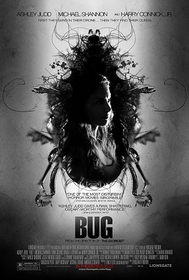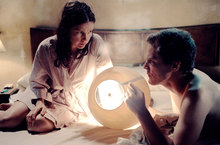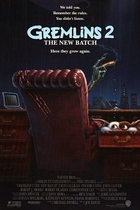Our editor-in-chief Nate Yapp is proud to have contributed to the new book Hidden Horror: A Celebration of 101 Underrated and Overlooked Fright Flicks, edited by Aaron Christensen. Another contributors include Anthony Timpone, B.J. Colangelo, Dave Alexander, Classic-Horror.com's own Robert C. Ring and John W. Bowen. Pick up a copy today from Amazon.com!
Bug (2006)
I had no intention of reviewing Bug when I pressed “Play”; however, 90 minutes later, I had no choice BUT to review it.
Directed by William Friedkin, Bug offers Agnes and Peter, blue-collar drifters who one evening randomly meet through a mutual friend, Agnes’s lesbian lover, and rush into a romantic relationship inspired by loneliness, physical attraction, psychological scars, and the shared intensity of their paranoid delusions.
Based on a play written by Tracy Letts (who won a Pulitzer Prize for Drama in 2008 for August: Osage County), Bug, like many plays adapted for the screen, craftily captures Aristotle’s classical unities of action, place, and time. Although a few subplots exist, Bug never detracts from its essence: the hyper-blossoming relationship between Peter and Agnes and the tragedy it instigates. Set in Oklahoma, Letts’s home state and a creepy reminder that sinister plots can explode anywhere – especially within the nation’s epicenter, the film transpires in Agnes’s seedy hotel room, which rapidly transforms into an insulated cell that physically resembles the psychological angst haunting this couple. And the action unfolds during a brief snapshot of hours in their lives. These dramaturgical qualities allow Friedkin to pay tribute to the narrative’s roots while molding Bug into a riveting psychological thriller ripe for contemporary audiences.
Bug doesn’t resort to cheap thrills, simple scares, or sudden surprises like many horror films. Instead, it draws upon terror’s essence: it’s a story about real diseases that happen to real people and the tragedies that surface to those seduced by Hope but confronting an uncooperative and uncompromising Fate. The greatest fear Bug evokes is this: our realities are often not real, but rather, mental artifices designed by our emotional, psychological, spiritual, and sexual needs.
Although Bug exemplifies the psychological thriller genre, its forays into science fiction, romance, and horror make it difficult to categorize. Part character study, part tragedy, part love story, and part post-modern melodrama, Bug gets under your skin quickly, like an aphid programmed to replicate. Friedkin, who directed genre classics such as The Exorcist and The French Connection, said during a 2007 NPR interview of Bug that it was “the most intense piece I've done.”
Like a 30-second scream that grows louder each second, Bug’s elegantly methodical pace pushes us further into the Darkness with each passing scene and builds its intensity like few other films. Initially, Bug lulls us into a mundane sleep that reveals the many colors of Agnes and Peter’s depressing, sordid, kaleidoscopic lives. Peter’s monotone voice, punctuated by short replies, slowly accumulates into poetic expositions about love, sickness, the military, and government conspiracies. Agnes’s gruff exterior undermines her sexy vulnerability, a shield that Peter’s disarming, simplistic charm quickly penetrates. However, that sleep quickly morphs into a shock-filled nightmare as the couple physically, psychologically, and spiritually become One.
Agnes, played poetically by Ashley Judd, is Charles Bukowski’s dream date: she works as a waitress in a lesbian bar and calls a dirty hotel room home. She suffers from a cocaine addiction, drinks whenever possible, and smokes weed even more frequently. As Pathos personified, she grieves for her kidnapped six-year-old son Lloyd and lives in fear from her abusive, ex-con husband, Jerry, played edgily by Harry Connick Jr. Imagine a blind date with her: most men would be running after only a few of those descriptions, but not Peter. He likes Agnes because although cornered by anxiety, she lives with quiet grace, managing each ugly second heroically as it unfolds, trying to do what’s right in a world constantly reminding her of what’s wrong.
Laced with contradictions, Judd’s portrayal of Agnes is painfully believable. Rejecting stereotypes, Agnes transcends sexuality and, like many of us, just wants love, but her life has been poisoned by broken relationships with the two most important males in her life, Jerry and Lloyd, so when the selfless Peter surfaces, the opportunity for renewal beckons. The symmetry they share is undeniable: they both defy easy sexual categorization, they both are on the run (Agnes from Jerry and Peter from the government), and they both suffer from unhealthy obsessions. Although initially cautious, she lunges into a relationship with this mysterious drifter that makes each second they spend together seem an hour. Her material world is beyond unimpressive, yet her soul, flawed and beaten, is beyond attractive. Few actors can make confusion, loneliness, addiction, and sickness seem so understandable. The ironic, orgasmic ecstasy she displays in the film’s final scenes, screaming, “I am the super mother bug queen,” as they consummate their disturbing union, is mesmerizing.
Played ingeniously by Michael Shannon (who also starred in the original stage production), Peter may be Jack Kerouac’s post-modern alter ego: initially, he arrives as a friendless, non-judgmental vagabond walking right off the pages of On the Road. He appears as a beat-like apparition in Agnes’s life one dark night. Saying all the right words, he offers Agnes a humble layer of protection from not only Jerry but also the demons that haunt her. Expecting nothing, Peter receives from Agnes what matters most: attention, affection, and ultimately, love. Peter, however, isn’t what he appears: he eventually reveals a disturbing, life-altering secret that’s forced him to live on the run from the military. Well, sort of, but not quite. Either way, that’s not good for Agnes, and escape is too late: in a demented, tragic way, their love has conquered all.
The familiarity, intimacy, and control that Shannon displays for the camera are inspiring. His portrayal of a paranoid schizophrenic may be the screen’s most maddening and convincing. His feverish rants unfold like post-modern soliloquies animated by seeds of evidence, but polluted by bizarre non-sequiturs that brazenly defy logic. Eventually, as he traps Agnes within his convoluted web of collusions, he connects national tragedies with personal loss, suggesting to Agnes relationships between Timothy McVeigh, the first Iraq War, government weapons testing, and the disappearance of Lloyd. Already seduced by his toxic charm, she embraces his narrative, and as the film marches towards its apocalyptic crescendo, the only reality for the couple is their present, which unfortunately has been electrified by fear, depression, paranoia, anxiety, and rejection, a wicked brew of emotions too intense to control. Sanity is beyond their grasp.
Throughout each character’s psychological descent, the set design engages with its economical and expressionistic props. The yellow hues remind us of the sickness that crawls within these walls. When Peter’s obsession about an apparent bug infestation compels him to decorate Agnes’s room with dozens of flypaper strips, those strips become bars, and the prison metaphor becomes obvious. Later, when Peter lines the room with tin foil, the couple’s insulation from reality is complete. The theme of paranoia infiltrates every component of the film, as the title suggests: essentially, Bug is about two people buggin’ out because government-implanted “bugs” appear in the form of, well, bugs. Yikes!
Hitting a number of critical social, cultural, and political notes, Bug should launch important questions about how America treats its veterans, the kind that should make conspiracy theorists drool. If Peter is a “poster-child” for Iraq War veterans, regardless of which war you’ve just summoned (Bush I’s or Bush II’s), why is he treated as an enemy? Who is the victim here? Peter or us? Are these wars nothing more than high-tech opportunities, or excuses, to test new weapons systems? And if they are, what does that say about the health and safety of the soldiers operating these untested weapons? What is America’s role in the proliferation of biological weapons? Are we our own worst enemy?
More importantly, since we know the U.S. military has used its own and allies’ soldiers as guinea pigs for nefarious purposes, Peter’s paranoia is compelling. It’s not surprising that the government a U.S. soldier was hired to protect targeted and victimized him. What is surprising is that such a sordid tale can unfold without media attention and a total lack of accountability. And what is tragic is how national agendas wreak havoc on the lives of private citizens: A complex web of innocent civilians relives the experiences of every U.S. soldier. Our political leaders should never forget that. When they do, they should watch Bug, which reveals these tragedies and raises those questions without getting preachy, a noble accomplishment indeed. Of course, the entire narrative could have been a warped hallucination concocted in Peter’s sick mind; nevertheless, as art and metaphor, its messages are invaluable.
Friedkin said the film is not a horror film but more “a black comedy love story”. I’m not sure about the black comedy part, but I certainly agree with the love story. As Peter and Agnes’s relationship grows, so does their paranoia, which draws an interesting connection between psychosis and love. Is there a difference? Is love a “healthy” form of psychosis or the most desirable of obsessions? Does their love blind their logic and thus produce more paranoia? Or does their paranoia bring them closer together, accelerating their love? Did Peter plan this manipulation all along, and if he did, was that conspiracy a product of his demented mental state? Or was it, like Agnes’s, a product of his lonely, depressed lifestyle, one that he saw reflected in Agnes, which drew him instantly closer to her? Bug offers no easy answers to any of these questions, only that the fine line dividing sanity and insanity is often erased by our emotions.
Bug is a film many horror fans might rewind immediately after it concludes. Throughout, I felt invitingly violated: for 90 minutes, reality was temporarily suspended; Friedkin & Co. had gone too far; and Judd and Shannon’s performances were so over the top I couldn’t help but let my jaw drop further. What I experienced was an ensemble of talented souls fully immersed in a tragic nightmare. In other words, a splendid way to spend another Saturday night.
Edelstein, David. “’Bug’ Out: Friedkin’s Latest Scratches Thriller Itch.” National Public Radio: May 23, 2007. htt p://www.npr.org/templates/story/story.php?storyId=10347272.
Grey, Ian. “The Eternal Struggle: From The Exorcist to Bug William Freidkin's movies examine people battling real and symbolic forces of evil.” Baltimore City Paper: May 23, 2007. http://www.cityp aper.com/film/story.asp?id=13637.










Wow! Great review and dead
Wow! Great review and dead on. I've seen it three times now and am mesmerized by the performances of the main actors.